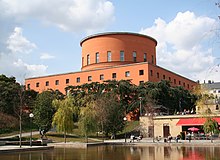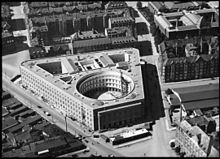Nordic Classicism
[1] Until a resurgence of interest for the period during the 1980s (marked by several scholarly studies and public exhibitions), Nordic Classicism was regarded as a mere interlude between two much better-known architectural movements, National Romanticism, or Jugendstil (often seen as equivalent or parallel to Art Nouveau), and Functionalism (aka Modernism).
But while Nordic Classicism was employed for a number of important public buildings, it was also applied as a model for low-cost housing (e.g. the Puu-Käpylä Garden Town, Helsinki (1920–25) by Martti Välikangas) and domestic architecture in general (e.g. an affordable sense of style for the nouveau riche).
Certain architects had reached the culmination of their careers already when the National Romantic style came, but their latter works were in the Nordic Classicism style (e.g. Carl Westman), the career of others culminated with Nordic Classicism (e.g. Ivar Tengbom and Ragnar Östberg), while others later went on to achieve far greater significance as Modernist architects (e.g. Arne Jacobsen, Alvar Aalto, and Sven Markelius).
Sirén, Alvar Aalto, Pauli E. Blomstedt, Elsi Borg, Erik Bryggman, Hilding Ekelund, Heikki Siikonen, and Oiva Kallio.
Durand at the École Polytechnique of Paris at the beginning of the 19th century had attempted to rationalise the language and building techniques of classicism, while allowing for simple additive compositions.
Scholars were at the time uncovering the remnants of Pompeii, and discovering the use of bright colour in Roman architecture – an aspect that had more or less been forgotten in the Renaissance, but also rediscovering Greece and Egypt.
Thus, when stirrings of political independence appeared in Finland and Norway, a rugged, national romantic architecture – a local variation of Art Nouveau – playing on the nationalistic myths, took hold.
A demonstration in real time of the move from Nordic Classicism to a pure Functionalism is offered by Alvar Aalto's design for the Viipuri Library (1927–35), which went through a profound transformation from the original architectural competition proposal in 1927 (owing much to Gunnar Asplund) to the severely functionalist building, completed eight years later in a purist modernist style, influenced by Le Corbusier.







